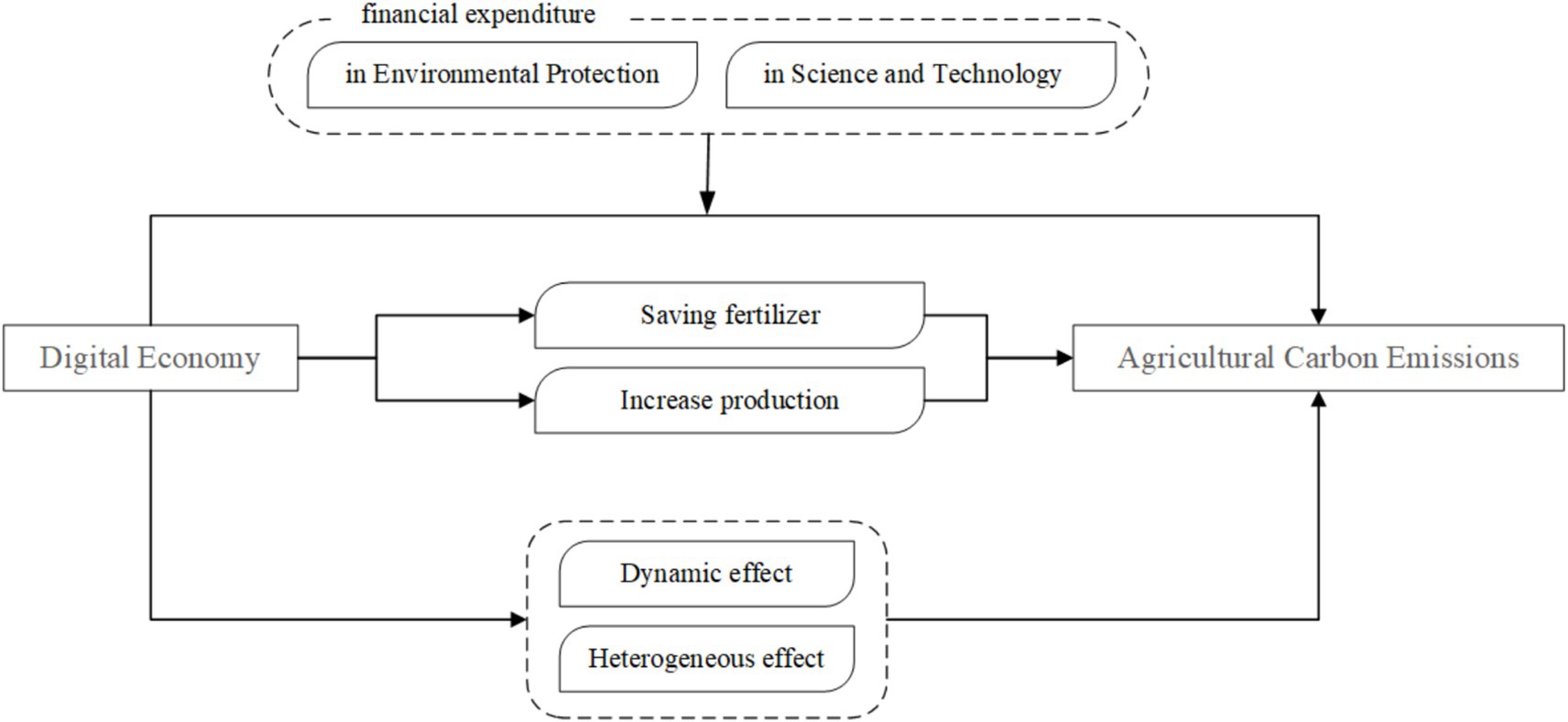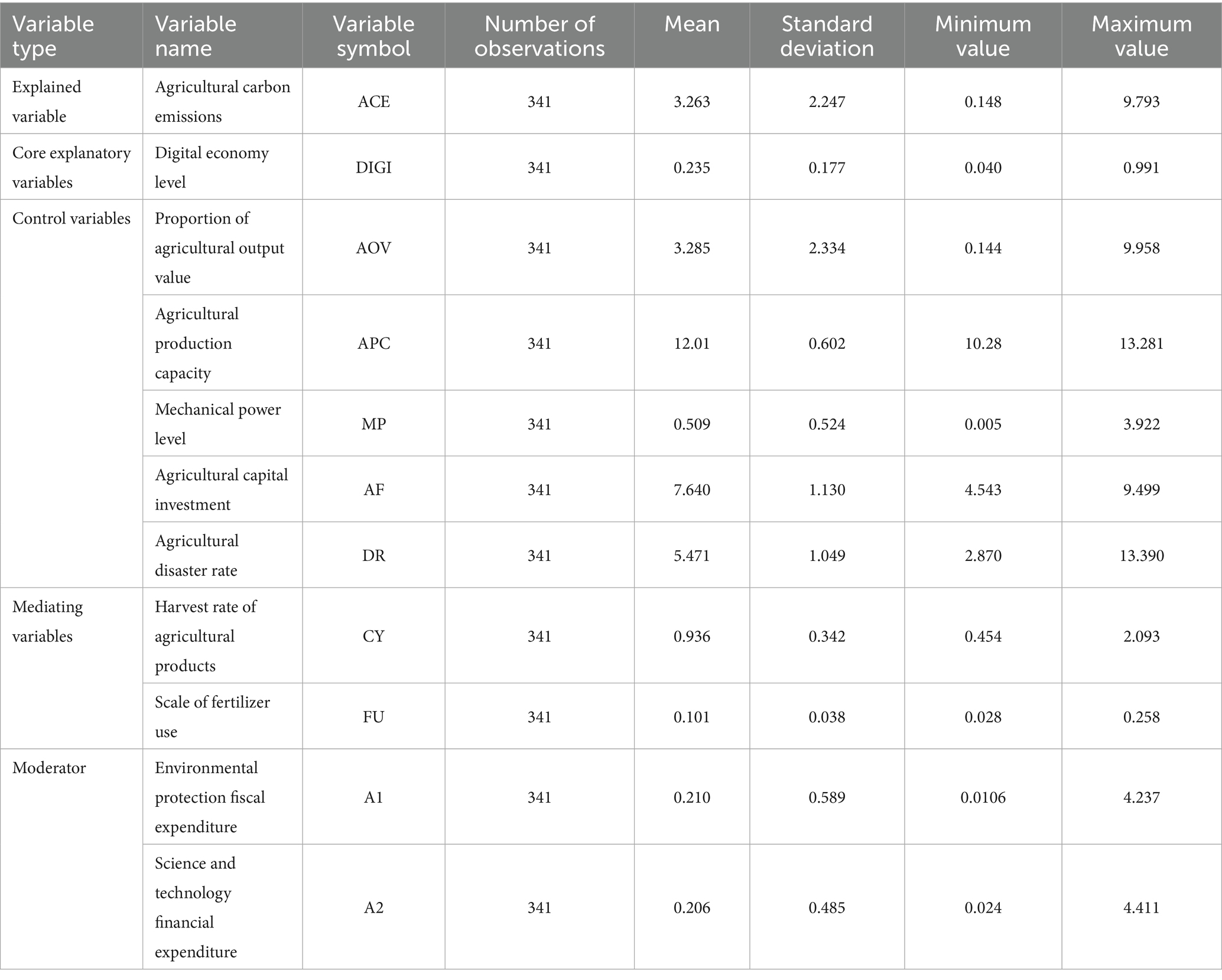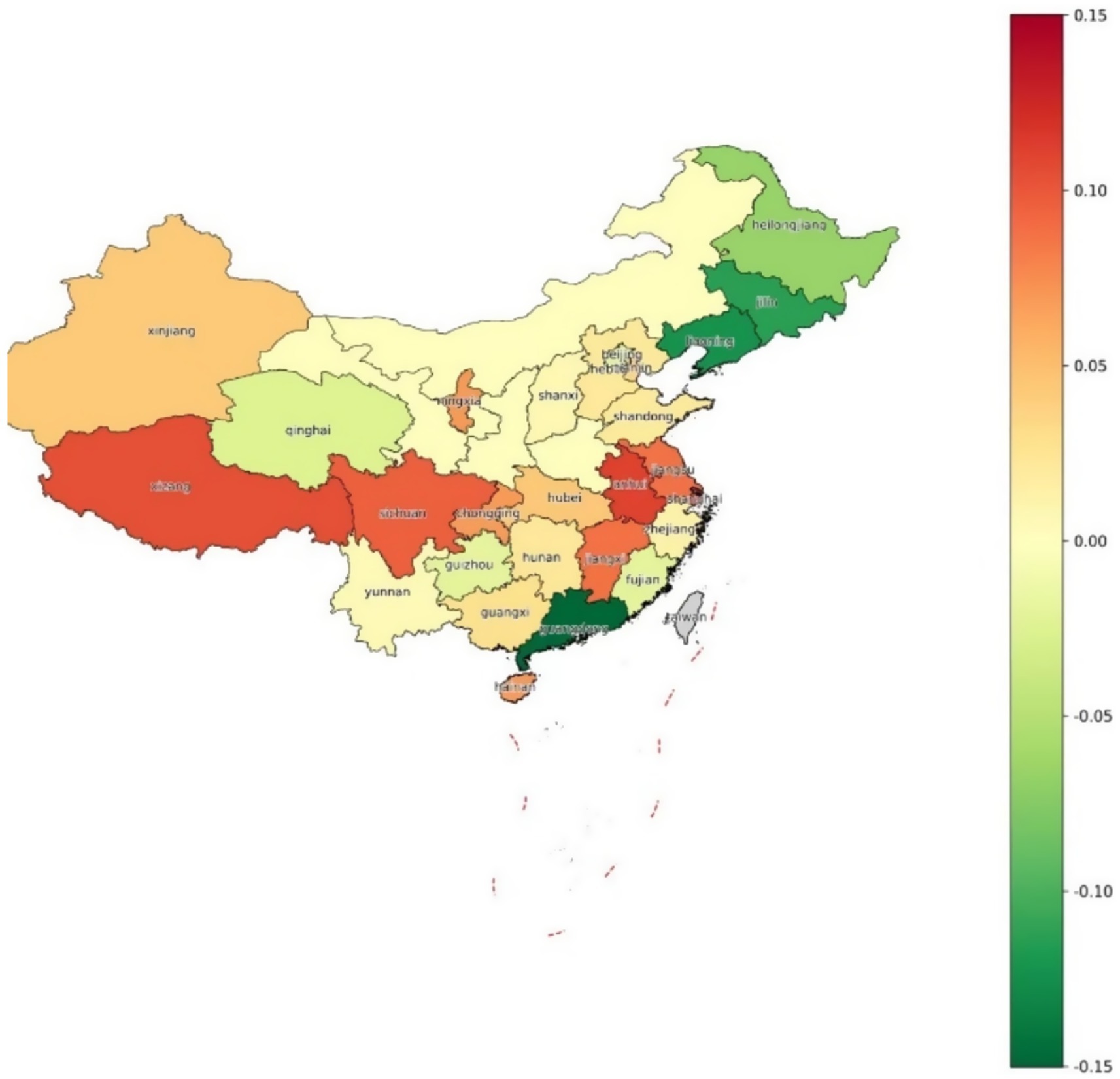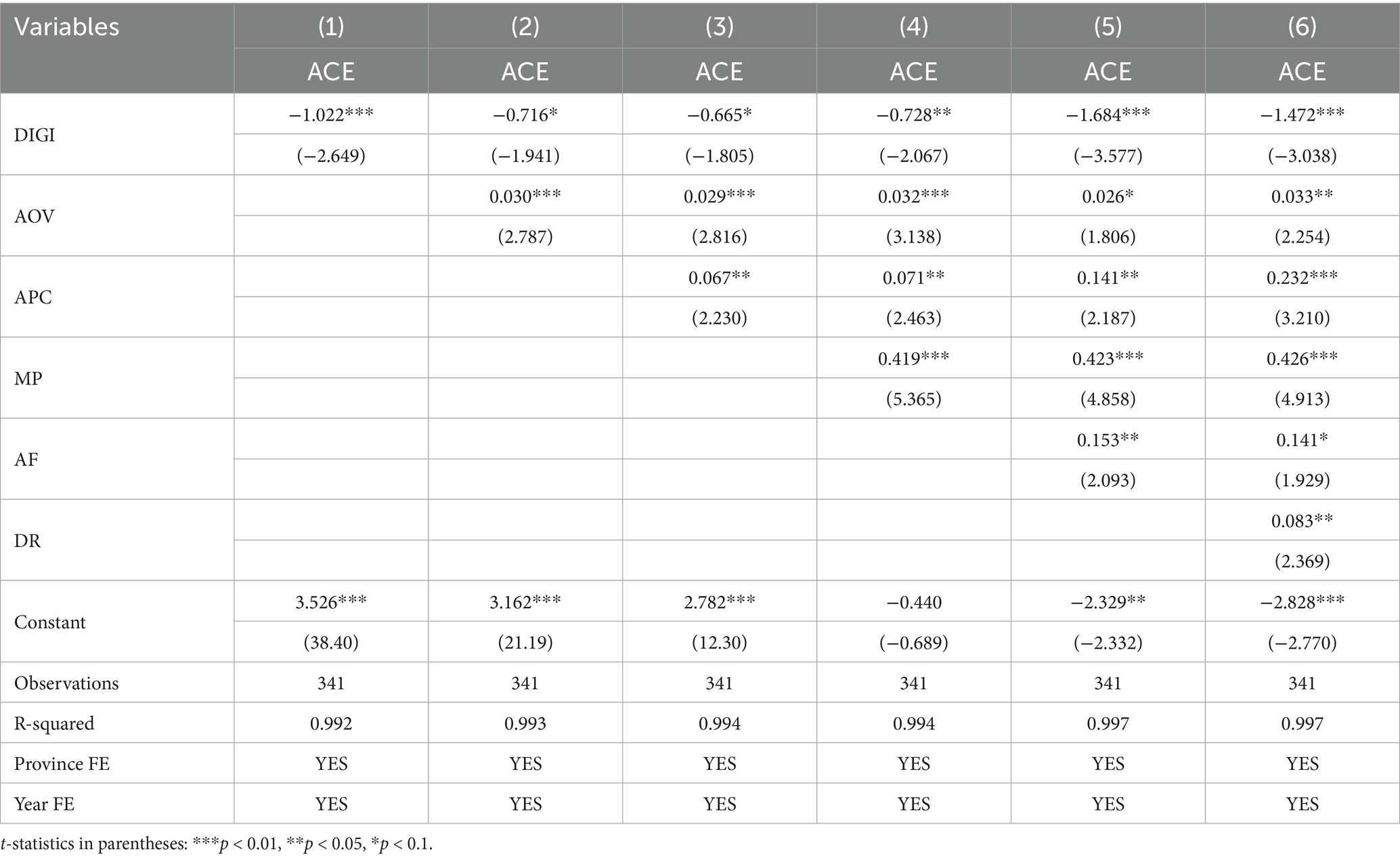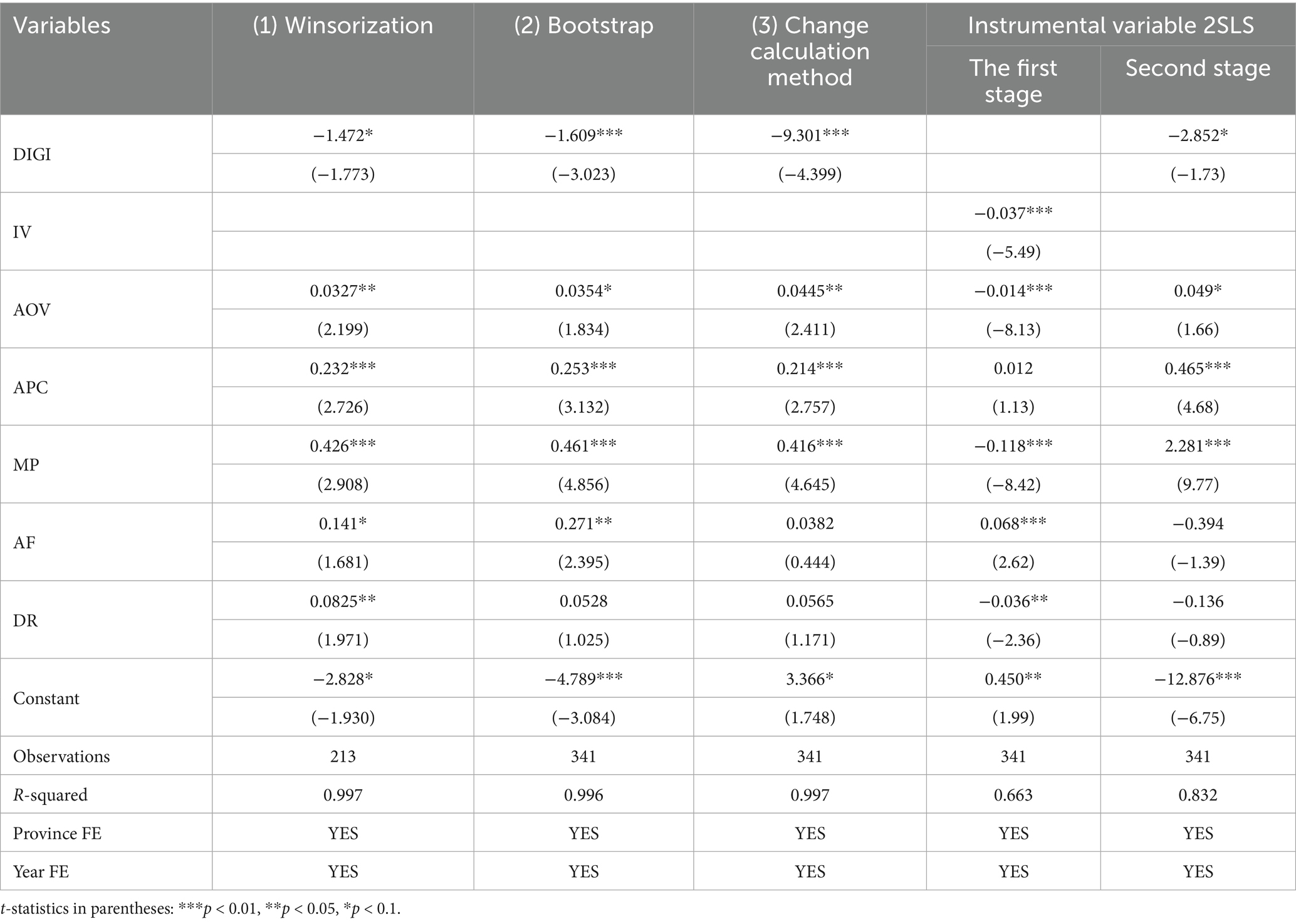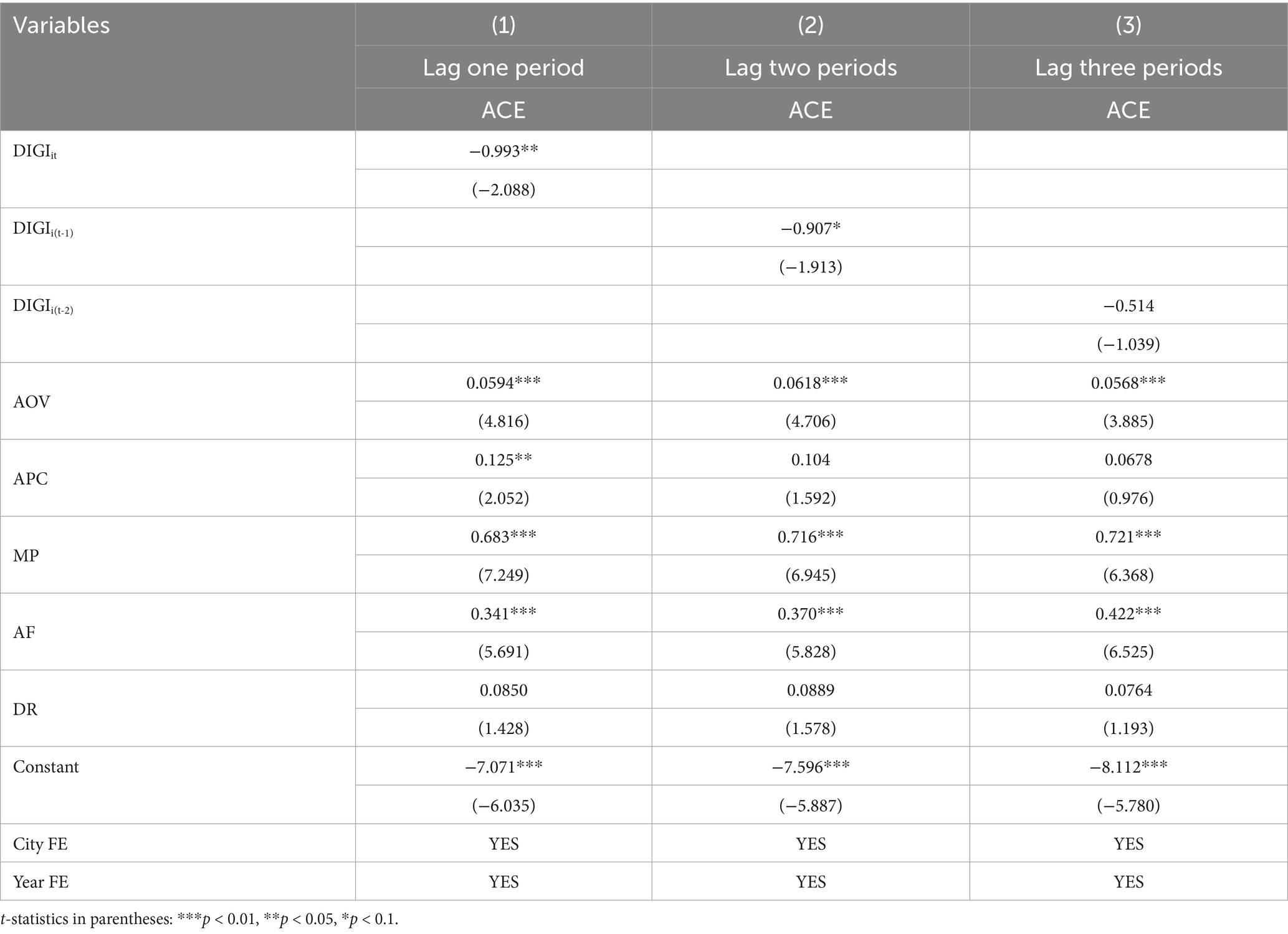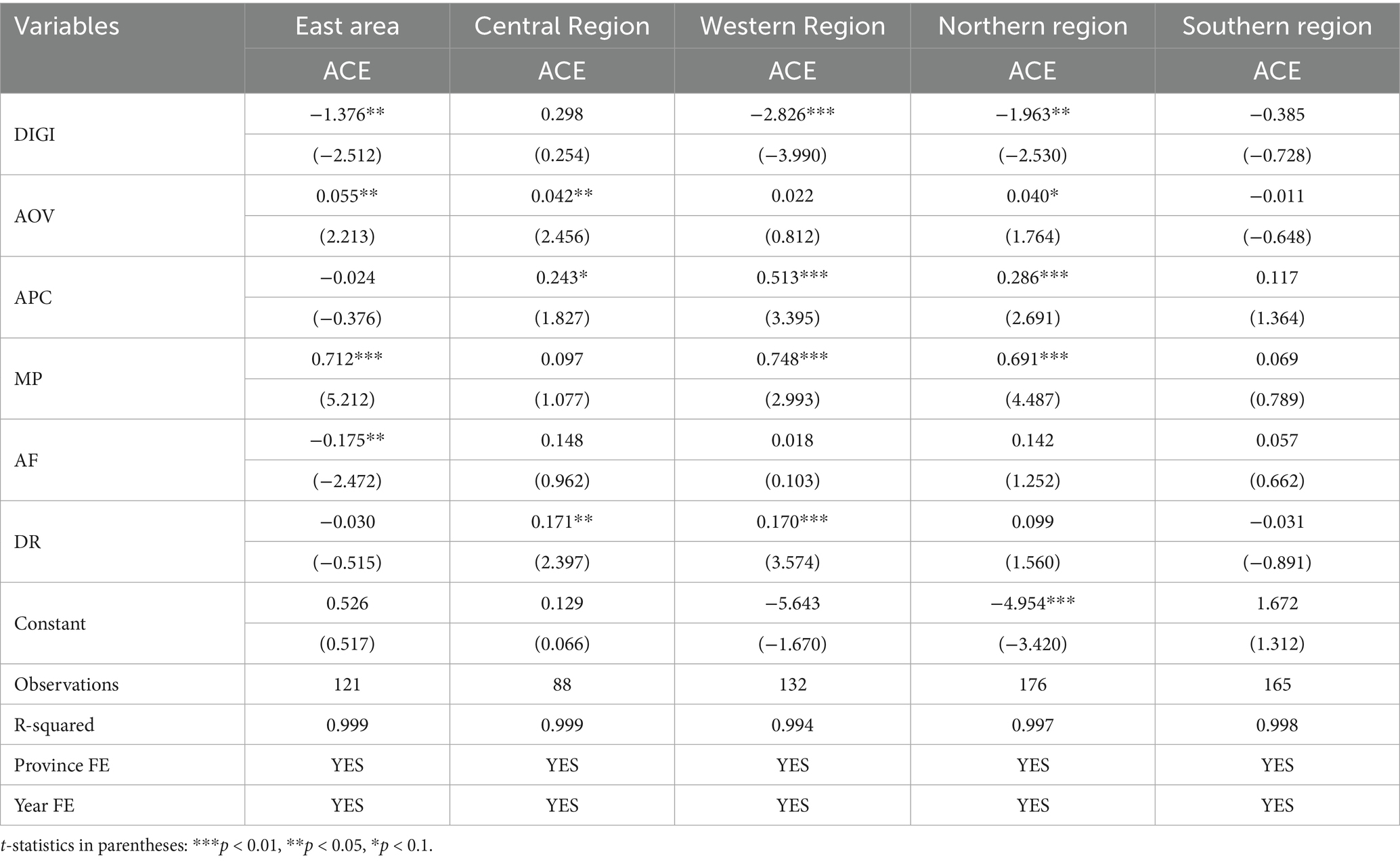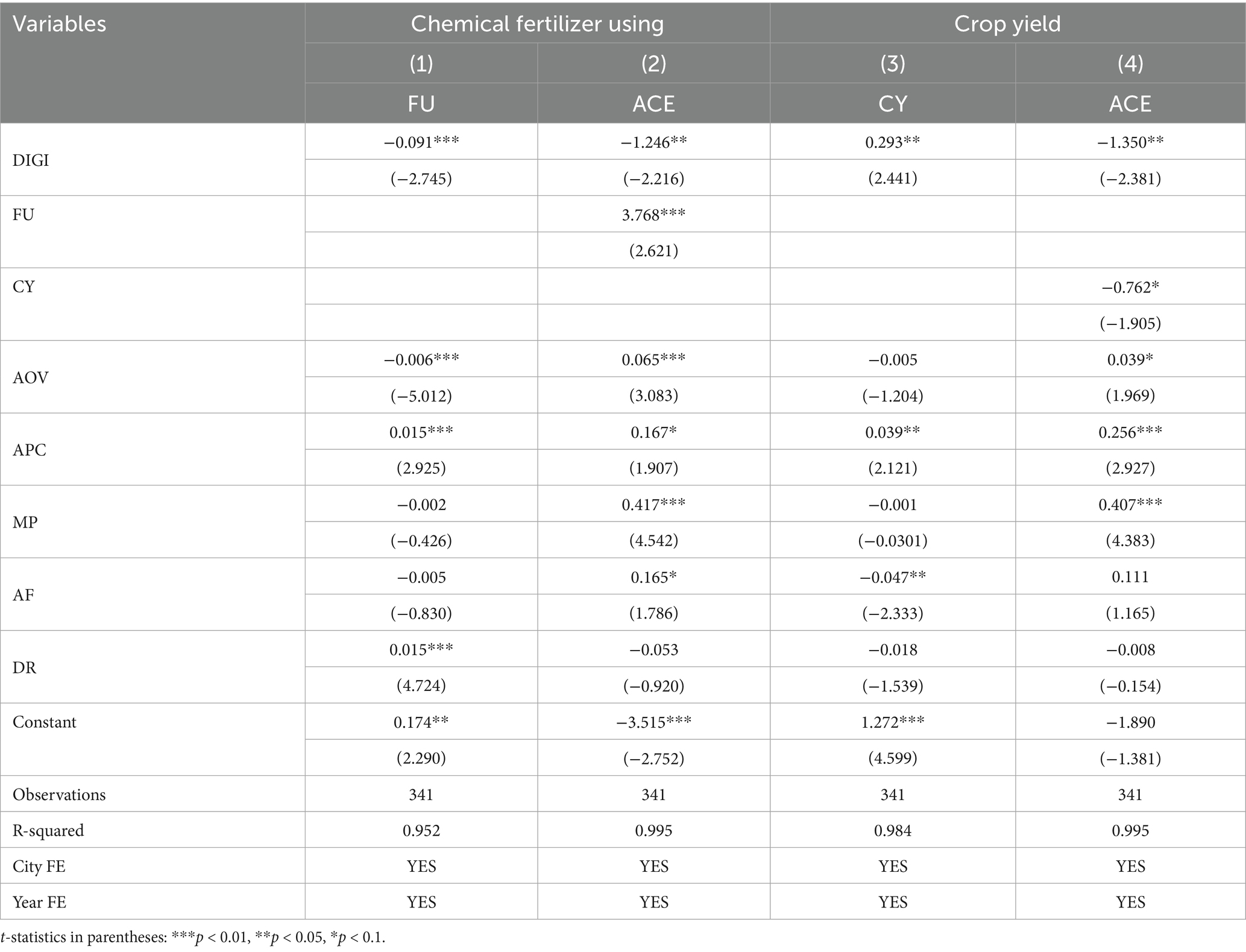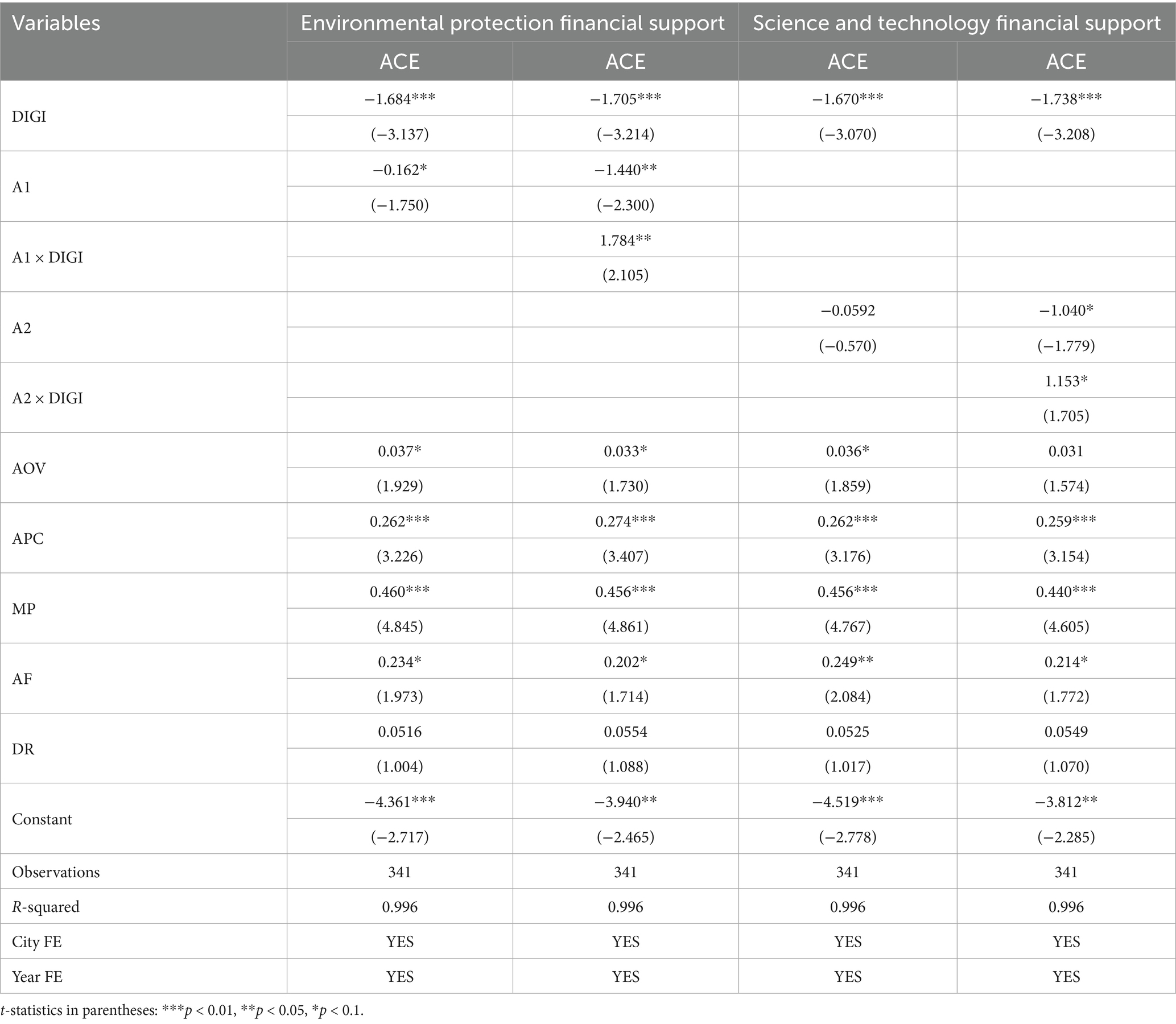- 1College of Economics and Management, Fujian Agriculture and Forestry University, Fuzhou, China
- 2College of Rural Revitalization, Fujian Agriculture and Forestry University, Fuzhou, China
Agricultural carbon emissions is one of the most important part of global greenhouse gasses, its governance is an significant action to deal with climate change and achieve SDG13. This study takes China, a large agricultural country, as an example. Using China’s provincial panel data from 2011 to 2021, the study empirically examines the relationship between the digital economy and agricultural carbon emissions, as well as its characteristic fact through a two-way fixed-effects model. It also explores the intrinsic mechanism of the two key variables from the perspective of government finance through the model of moderating effects. The conclusions indicate that: the increase of the level of digital economy within the station has a notable inhibitory effect on the agricultural carbon emissions; in terms of the temporal effect, the inhibition of the digital economy on the agricultural carbon emissions is not only reflected in the current period, but also in the next two periods; In relation to the spatial heterogeneity, the effect of carbon emission reduction in the agricultural field shows the following characteristics spatial distribution, the reduction effect presents the spatial distribution characteristics of “west > east, central is not obvious,” “the north is significant, the south is vice versa”; As for influence mechanism, the government’s financial support in environmental protection and financial support in the field of science and technology positively catalyzes the suppression effect of the digital economy on the agricultural carbon emissions. The mechanism of influence, There is an intermediary way to reduce the use of agricultural chemical fertilizers and increase the yield of agricultural products in the inhibitory effect of digital economy on agricultural carbon emissions. in addition, the government’s financial support in environmental protection and financial support in the field of science and technology have positively catalyzed the carbon reduction effect of digital economy in the field of agriculture, which provides empirical evidence for exploring the carbon reduction path of agricultural digital transformation and the synergistic effect of “policy technology” in sustainable agricultural development.
1 Introduction
The unprecedented ramifications of escalating global temperatures and climatic extremes are posing formidable challenges to both terrestrial ecosystems and human civilizations. Anthropogenic greenhouse gas (GHG) emissions stand as the primary culprit behind this global thermal anomaly. The AR6 Synthesis Report1: Climate Change 2023 elucidates that human-induced factors have precipitated a 1.1°C surge in global mean temperature, catalyzing a cascade of environmental perturbations, including oceanic expansion, acidification of marine habitats, sylvan degradation, and aridification of landscapes. These transformations portend grave implications for both anthropogenic and natural systems. In this milieu, agriculture, the bedrock of human sustenance, emerges as a pivotal contributor to carbon fluxes throughout its evolutionary trajectory. Food and Agriculture Organization (FAO) data reveal a 17% escalation in global GHG emissions associated with agrarian practices and food production over the past three decades. Global food production is heavily dependent on fossil fuels, causing serious environmental problems. Moreover, carbon efflux from agricultural endeavors has assumed increasing significance in exacerbating climate change. SDG13 requires countries to clarify their carbon reduction pathways and promote emission reduction efforts through funding and technology transfer. Consequently, the mitigation of these emissions has become a focal point of global scientific inquiry, aimed at attenuating the ramifications of extreme climatic fluctuations.
As an agricultural juggernaut, China has consistently prioritized the advancement of its agrarian sector. Agriculture exhibits a dual attribute as both a carbon source and sink, exerting a profound influence on global climate dynamics. Chinese agricultural GHG emissions constitute 17% of the global aggregate, ranking second only to the energy sector, and demonstrating an average annual growth rate of 5%. This predicament has catalyzed governmental prioritization at the policy echelon. The recently announced “14th Five-Year Plan for National Green Agricultural Development” (which is China’s major development plan to speed up comprehensive green transformation of agriculture) outlines ambitious targets for 2025, including substantial promotion of environmentally friendly farming practices, coupled with significant improvements in reducing emissions and enhancing carbon sequestration abilities. In light of this, agricultural carbon abatement has surfaced as a crucial approach for balancing economic gains with ecological conservation, reinforcing the resilience of the agrarian sector and paving the way for sustainable agricultural progress.
Since the inception of Chinese “12th Five-Year Plan,” China’s agricultural sector has orchestrated and implemented a comprehensive suite of initiatives centered on the tripartite objectives of “one control, two reductions, and three fundamentals.” These endeavors focus on regulating agricultural water consumption, curtailing fertilizer and pesticide application, mitigating livestock and poultry effluents, promoting the recycling of agroplastics, and suppressing straw incineration. The overarching aim is to catalyze a verdant and low-carbon metamorphosis of the agricultural landscape while decoupling food security from carbon emissions. In 2022, China promulgated the “Implementation Plan for Agricultural and Rural Emission Reduction and Carbon Sequestration,” a strategic blueprint designed to augment soil carbon sequestration capacity, establish a robust action framework for the “dual carbon” goals, and achieve substantive progress in agricultural sustainability initiatives. This plan represents a significant stride toward harmonizing agricultural productivity with environmental stewardship. Notwithstanding these laudable efforts, the path toward agricultural carbon abatement remains fraught with multifaceted challenges. The constraints imposed by the exigencies of large-scale production, the insufficiency of foundational infrastructure for carbon sequestration, the inherent heterogeneity of agricultural production processes collectively present formidable obstacles. These impediments underscore the complexity of transitioning toward a more sustainable agricultural paradigm and highlight the need for continued innovation and adaptation in policy and practice.
The current global energy crisis presents a dual feature of rising fuel costs and fragile supply chains, which forces the agricultural system to accelerate technological innovation to reduce dependence on fossil fuels and carbon emissions intensity in agricultural production. Meanwhile, the rise of new economic forms centered on digital technology has provided a way to agricultural modernization. Digital agriculture, smart agriculture and digital countryside and other new models emerge in the field of “three rural,” innovation in modern agricultural production technology, empowered by the development of agricultural mechanization, leading the quality and efficiency of agricultural production. However, in the exploration of agricultural intelligence, can digital technology become a subversive key technology to increase production and reduce emissions? Can digital economy be an effective tool of agricultural carbon emission reduction? Can new industries be used to empower the cause of carbon emission reduction? Faced with the global commitment to building a community of human destiny and addressing climate change, this study investigates and answers the above questions, to explore the win-win situation of “emission reduction and efficiency improvement” in the agricultural field through digital means, and to provide empirical evidence for exploring the carbon reduction path of agricultural digital transformation and the synergistic effect of “policy technology” in sustainable agricultural development.
2 Literature review
Agricultural carbon emissions, as critical anthropogenic contributions to atmospheric carbon flux, have increasingly garnered scholarly attention. This research area is vital for achieving China’s “dual carbon” goals and facilitating the transformation of agricultural economic paradigms. The body of pertinent studies mainly focuses on four key aspects: measuring agricultural carbon emissions, clarifying their spatiotemporal distribution characteristics, identifying influential determinants, and developing carbon mitigation strategies.
Given the expansive scope and intricate production processes inherent in agricultural carbon emission calculations, and constrained by data availability, domestic and international scholars have concentrated their efforts on six primary carbon sources for quantifying agricultural carbon emissions: fertilizer application, pesticide utilization, agroplastic deployment, agricultural diesel consumption, soil tillage practices, and irrigation systems (Wu et al., 2014; Liu and Gao, 2022; Koondhar et al., 2021). Analytical findings reveal that agriculture has become the second-largest contributor to global carbon emissions, highlighting the pressing need to promote agricultural carbon reduction measures for implementing global carbon constraint policies and mitigating the climate crisis (Liu and Yang, 2021). Since 2000, China’s agricultural carbon emissions and agricultural output value have shown a positive correlation, generally exhibiting a trajectory of initial increase followed by subsequent decrease. The spatial distribution of these emissions is characterized by a gradient of diminution from east to west across the country (Su et al., 2023; Yang et al., 2022; Zhang et al., 2022). In recent years, China has actively pursued strategies to balance agricultural carbon emission intensity with the goal of ensuring a stable and secure supply of staple grains and key agricultural products. From an inter-provincial perspective, robust spatial interconnections and spillover effects in agricultural carbon emissions have been observed among China’s provinces (Liu and Yang, 2021). With respect to watershed distribution, empirical studies reveal that agricultural carbon emissions in downstream areas surpass those in upstream and midstream regions (Liu and Gao, 2022).
The multifaceted nature of agricultural carbon emissions has prompted extensive scholarly investigation into their underlying determinants and potential mitigation strategies. A comprehensive analysis of the current landscape reveals a complex interplay of factors influencing agricultural carbon flux. Several studies have elucidated that the intensification of agricultural specialization correlates positively with elevated carbon emissions. This relationship manifests through enhanced mechanization and increased utilization of fertilizers and agricultural inputs, consequently amplifying the magnitude of agricultural carbon emissions (Wang et al., 2022; Raihan and Tuspekova, 2022). Furthermore, a constellation of factors including industrial structure, economic growth trajectories, public environmental consciousness, transportation infrastructure scale, agroplastic utilization, and energy inputs have been recognized as major factors driving the increase in carbon emissions from agriculture (Raihan et al., 2023; Cao et al., 2023; Zhu et al., 2023; Wang et al., 2024; Zhao et al., 2018; Tongwane et al., 2020). Building upon these insights, researchers have pivoted their focus toward the formulation of carbon abatement measures. Empirical evidence suggests that alleviating rural energy poverty can have a suppressive impact on agricultural carbon emissions, with this suppression effect significantly moderated by resource endowment. High resource endowment has been observed to positively catalyze the carbon reduction efficacy of energy poverty alleviation initiatives (Li J. et al., 2023). Moreover, the implementation of judicious agricultural policies, particularly those involving financial support mechanisms, has demonstrated efficacy in promoting carbon reduction (Du et al., 2023; Ganda, 2023). Environmental regulations, farmland transfer schemes, land hardening practices, green technology innovation, and clean energy substitution have also been identified as notable contributors to agricultural carbon abatement efforts (Janus and Ertunç, 2023; Shabbir Alam et al., 2023; Li L. et al., 2023; Liu et al., 2021; Zhang et al., 2024).
The international energy crisis and carbon neutrality goals have forced technological innovation in the agricultural sector, and the development model of precision agriculture driven by intelligence and data has provided a new path to reduce the dependence of agricultural production on fossil fuels, improve energy efficiency, and reduce carbon footprint (Costa et al., 2023). On one hand, the digital economy fortifies the foundation for agricultural carbon abatement by fostering technological innovation and facilitating industrial structure transformation and upgrading (Turid et al., 2022). Agricultural digitalization augments resource utilization efficiency, enabling agricultural production activities to strike a balance between scale benefits and emission reduction imperatives (Fan et al., 2023). Furthermore, research has illuminated that technological progress and increased investment can attenuate agricultural carbon emission intensity through the mediating pathways of enhanced human capital and elevated urbanization levels. The emission reduction effects engendered by digitalization in the agricultural sector exhibit sectoral heterogeneity, specifically manifesting in distinctive characteristics across crop cultivation and animal husbandry domains (Zhao et al., 2023; Wei Z. et al., 2023; Liu and Yang, 2021).
Amid the shift toward a digitalized economy, China seeks to forge an innovative path for agricultural advancement that balances food sustainability with environmental stewardship. Current scholarly work on emissions largely centers on quantification, patterns, and causal factors. Analyses of digital economic impacts on carbon output typically adopt a broad macroeconomic lens, with limited sector-specific scrutiny. This study’s novel contributions are threefold:
First, it examines the intersection of digital transformation and farm-related emissions, aiming to uncover cutting-edge strategies for mitigation in the agricultural sector, systematically explained how the agricultural sector can achieve a win-win situation of emission reduction and efficiency improvement through technological adaptation, providing a feasible micro path for agricultural carbon neutrality.
Secondly, through an assessment of diffuse agricultural pollution sources and associated quality and efficiency targets, this research explores how digitalization influences fertilizer usage and crop yields, By incorporating non-point source pollution into the analysis framework, it identified the intermediary transmission chain of “technology adoption → resource optimization → carbon reduction” in the agricultural sector.
Thirdly, from the perspective of government intervention, the strengthening role of ecological subsidies in the relationship between “digital technology emission reduction performance” has been verified, and the synergistic effect of policies and technology in sustainable development has been elucidated.
This investigation offers fresh perspectives for China and beyond on leveraging digital advancements to simultaneously reduce agricultural emissions and boost productivity, underpinned by strategic fiscal support.
3 Impact mechanism and research hypotheses
3.1 Impact mechanism
Amidst the global warming crisis, agriculture must undergo a transformative phase, shifting from “polluting” practices to “environmentally friendly” approaches and reducing carbon emissions. This imperative has led to the emergence of the low-carbon agriculture theory. This concept emphasizes sustainable development in the agricultural sector, seeking to explore efficient and low-consumption modern agricultural models through technological advancements, paradigm shifts, and industrial transformation (Sui et al., 2024). The theory advocates for a comprehensive approach to revolutionize agricultural practices, focusing on minimizing environmental impact while maximizing productivity. It encompasses the implementation of cutting-edge technologies, the reformation of traditional farming methods, and the restructuring of agricultural industries to achieve a harmonious balance between economic viability and ecological sustainability. The digital economy, underpinned by cutting-edge digital technologies, permeates diverse business sectors, catalyzing their metamorphosis and enhancement while concurrently presenting opportunities for low-carbon agricultural development. On one front, the digital economy empowers agricultural production processes through automation and intelligent methodologies, augmenting production efficiency via technological upgrades, and mitigating resource waste and emissions per unit of output (Xiong et al., 2023). Conversely, by integrating Internet of Things (IoT) technology with agriculture, the digital economy spawns innovative production models such as “Internet+” and “Smart+,” facilitating precise fertilizer application, real-time monitoring of crop phenology, scientific energy consumption control, judicious allocation of land resources, and efficiency management across various stages of the agricultural value chain. This approach optimizes fertilizer use efficiency, curtails energy consumption, and achieves the dual objectives of enhancing agricultural productivity while reducing emissions (Pang et al., 2024; Şerbu, 2014). Moreover, the spillover effects of digital technology can foster local technological advancement, accelerating the integrated innovation and technological breakthroughs of key green technologies in emission reduction and carbon sequestration. This entire process not only lays the foundation for the future development of agriculture but also propels regional low-carbon transformation and the construction of an ecologically friendly economy. The implementation of low-carbon agricultural practices serves as a catalyst for broader environmental and economic shifts. It fosters the creation of sustainable agricultural ecosystems that harmonize with natural environments, while simultaneously driving innovation in related industries and technologies (Abbas et al., 2024; Dai et al., 2023). Building on the above analysis, Hypothesis 1 is put forward.
Hypothesis 1: The digital economy exerts a mitigating effect on agricultural carbon emissions, meaning that as the digital economy develops further, agricultural carbon emissions tend to decline.
The evolution of the digital economy represents a dynamic and continuous process, necessitating systematic planning and adaptive strategies for infrastructure development, technological iteration, and the concrete implementation of digital transformation. Consequently, within the agricultural sector, the influence of the digital economy on carbon emissions will not manifest immediately. Instead, it will gradually emerge over time and continue to influence carbon emission levels for an extended period in the foreseeable future (Zhao et al., 2023). The automation and intelligent technology advantages conferred by the digital economy not only empower current agricultural production but are poised to positively influence future agricultural production efficiency and ecological benefits. From a short-term perspective, the salubrious effects of the digital economy on agricultural carbon reduction are primarily manifested through precise monitoring of energy consumption and resource utilization, optimized allocation of production factors, and significant enhancements in production efficiency, thereby achieving the dual objectives of resource conservation and carbon emission mitigation (Yu et al., 2022). In the long term, as the sophistication of the digital economy advances, accompanied by gradual technological breakthroughs, comprehensive policy implementation, and progressive infrastructure enhancement, it will incrementally empower all facets of agricultural production, generating a “reservoir” effect. This will catalyze further optimization of agricultural structures and innovate agricultural production models, achieving sustained carbon reduction effects through paradigms such as green agriculture and organic agriculture (Ma et al., 2022; Liu J. et al., 2023; Liu Y. et al., 2023). Furthermore, given the diversity of China’s geographical and economic structures, the impact of the digital economy on agricultural carbon reduction will vary across regions. China’s topography is characterized by a stepped distribution, with elevations gradually decreasing from the higher regions in the west to the lower areas in the east. Simultaneously, there are significant differences in industrial structures between the northern and southern regions. Consequently, the effects of the digital economy on agricultural carbon reduction may exhibit heterogeneity across these diverse landscapes (Su et al., 2023). Thus, Hypothesis 2 is formulated.
Hypothesis 2: The digital economy's influence on agricultural carbon emissions has a continuing effect, that is, the improvement of the current level of the digital economy will also lower future agricultural carbon emissions.
From the perspective of internal influence logic, precision agriculture and smart agriculture, driven by intelligence and digitization, can control the use of fertilizers and other energy sources, replace extensive energy input with precision operations, improve agricultural production efficiency, and reduce traditional agricultural path dependence. The increasing integration of digital technology with agricultural sector provides a robust foundation for low-carbon, high-efficiency agricultural development. This synergy manifests through two primary mechanisms: Firstly, digital technology empowers agricultural production by promoting the development of ecological agriculture through intelligent and data-driven approaches. This paradigm shift enhances the precision management and monitoring capabilities within agricultural production systems, enabling judicious fertilizer application and thereby mitigating the deleterious environmental impacts associated with excessive use, such as the production and use of chemical fertilizers produce carbon emissions, which is one of the important sources of carbon emissions (Yang et al., 2024). The promotion of intelligent green production technologies, exemplified by soil testing and formula fertilization techniques, has yielded notable improvements in fertilizer utilization efficiency. This optimization has concomitantly reduced the squandering of fertilizer resources, alleviated agricultural non-point source pollution, and simultaneously diminished crop yield reductions and greenhouse gas emissions attributable to fertilizer misuse (Guo and Zhang, 2023). Secondly, the advent of smart agriculture has significantly augmented agricultural production efficiency and crop yields through the implementation of optimal fertilizer ratios, precision irrigation systems, and agricultural machinery upgrades (Abiri et al., 2023). Smart agriculture not only increases the economic benefits of crops per unit area but also effectively mitigates issues of resource waste and increased carbon emissions resulting from manual labor costs and excessive land reclamation. Consequently, Hypothesis 3 is put forward:
Hypothesis 3: there is a transmission path of fertilizer saving and income increase in the suppressive effect of digital economy on agricultural carbon emissions.
Government involvement is essential for reducing agricultural emissions. Studies show that when policymakers prioritize addressing farm-related carbon output through legislative measures, rigorous oversight, and monetary incentives, significant reductions can be achieved (Chen et al., 2024). As global economic landscape shifts toward a digital paradigm, authorities are increasingly recognizing the role of technological innovation in meeting environmental goals (Zhao et al., 2023). Fiscal expenditure in the scientific and technological domain emerges as a crucial investment mechanism for driving technological innovation, instrumental in surmounting digital technology challenges and enhancing innovation efficiency (Pan and Zhang, 2023). On one hand, the government promotes technological innovation through fiscal investments, enhancing the application of digital technologies in agriculture. This financial support facilitates agricultural digital transformation, improving production efficiency, increasing agricultural product diversity, empowering agricultural production, and achieving modernization and high efficiency in agricultural activities. On the other hand, fiscal support for science and technology optimizes the allocation of resources such as information, talent, and technology in the digitalization process, fostering economic digitization. This not only helps optimize industrial structures and improve technological efficiency but also strengthens the contribution of the digital economy to carbon emission reduction (Yu et al., 2023). Therefore, the more fiscal funds the government invests in the scientific and technological domain, the more it can drive technological innovation and digital economic development, which is crucial for attaining efficient carbon reduction in the agricultural sector.
Moreover, fiscal expenditure in the environmental protection sector, as a crucial instrument of governmental environmental regulation, also contributes significantly to enhancing the reduction impact of the digital economy in the agricultural domain. This fiscal strategy operates through multiple interconnected mechanisms: Primarily, environmental protection fiscal support catalyzes the synergistic integration of digitalization and greening processes. This integration fosters innovation in green production technologies and accelerates supply-side reforms in the agricultural sector, while simultaneously enhancing green total factor productivity (Chen and He, 2024). This holistic approach ensures that digital innovations are intrinsically aligned with sustainability goals, creating a symbiotic relationship between technological advancement and environmental stewardship. Within this context, specific fiscal measures such as carbon sink subsidies and emission reduction incentives embedded in environmental protection expenditure serve dual purposes. Firstly, they directly inhibit carbon emissions in the agricultural sector (Raihan et al., 2023; Wei S. et al., 2023), providing immediate and tangible benefits to the environment. Secondly, and perhaps more significantly, these measures generate an “innovation compensation” effect as an incentive-based environmental regulation. This effect stimulates technological innovation, propelling the application of digital technologies in green development initiatives, and facilitating the transition of the agricultural economy toward a green, low-carbon model (Clò et al., 2022). Specifically, as environmental protection fiscal support intensifies, the promotional effect of the digital economy on green agricultural development becomes increasingly pronounced. Based on these considerations, Hypothesis 4 is proposed.
Hypothesis 4: Government financial support in environmental protection and science and technology positively catalyze digital economy’s inhibition on carbon emissions in agricultural sector.
4 Model construction and data description
4.1 Measurement model setting
What are the effects, direction, and magnitude of digital economic development on agricultural carbon mitigation? To address these inquiries, this research employs a benchmark regression analysis.
As shown in Equation 1, represents the total agricultural carbon emission of province in year ; refers to the level of digital economic development of each province; is a set of control variables including the proportion of agricultural output value ( ), agricultural production capacity ( ), mechanical power level ( ), agricultural financial input ( ), and the rate of agricultural disaster ( ). is the set of control variables including agricultural output share ( ), agricultural production capacity ( ), mechanical power level ( ), agricultural financial input ( ), and agricultural disaster rate ( ), and the five control variables affecting agricultural carbon emissions. is the individual fixed effect, represents the year fixed effect and is the error term in the model.
Implementing digital technologies in agriculture involves a gradual process of planning, research, and application, resulting in a time lag. This delay means that the digital economy’s influence on farm-related carbon output is not immediate. A dynamic temporal relationship exists between digital advancements and agricultural emissions, with current technological progress potentially shaping future environmental outcomes in the sector. To verify this temporal dynamic effect (hypothesis 2), the study applied time lag treatment to the core explanatory variable, introduced a benchmark regression model, and constructed model (2). In the formula, is the number of lag periods.
To uncover the underlying mechanisms by which digital economic growth affects agricultural sustainability, the research develops a mediation model based on Hypothesis 3. Equations 3, 4 incorporate mediating variables that measure fertilizer usage efficiency and agricultural productivity.
In recent years, China has heightened its focus on digital transformation and environmental sustainability, steadily increasing budgetary allocations for technological innovation and eco-friendly farming practices. To evaluate hypothesis 4, this study incorporates moderating factors into the benchmark regression model. These factors include governmental spending on environmental conservation and research and development, allowing for an assessment of how public financial support influences the relationship between digital advancements and agricultural sustainability.
4.2 Variable description and data source
This study examines 31 mainland Chinese provinces from 2011 to 2021, excluding Hong Kong, Macao, and Taiwan. Primary data sources include the “China Statistical Yearbook” and “China Rural Statistical Yearbook.” The agricultural database utilizes 2004 as the base year for RMB-denominated figures, which have been adjusted for inflation. Linear interpolation was employed to address missing data points. Key variables selected for analysis are as follows:
4.2.1 The explained variable—agricultural carbon emissions
Based on extant research (Wu et al., 2024), agricultural carbon emissions are primarily calculated by aggregating emissions from six carbon sources: fertilizer application, pesticide spraying, plastic film usage, mechanical fuel consumption, agricultural irrigation, and agricultural tilling. The specific calculation is delineated in Equation 8, where and denote the type of carbon source and year, respectively. represents the emission quantity of the carbon source, and signifies the carbon emission coefficient for each source. The specific values and data sources for these coefficients are elucidated in Table 1.
4.2.2 Core explanatory variable – level of digital economy
This study adopts Zhao et al. (2020) methodology to quantify explanatory variables. A comprehensive index system is developed to assess regional digital advancement, focusing on internet infrastructure and financial technology integration. The entropy method is utilized to streamline indicator dimensions, yielding a composite digital economy score for each province. Detailed indicator criteria are outlined in Table 2.
4.2.3 Control variables
Existing research indicates that agricultural carbon emissions are influenced by multiple factors. This study selects five of the most critical variables as control variables for model (1). The primary indicators comprise: agricultural output value proportion (expressed as the share of agricultural output in GDP, %), agricultural production capacity (quantified by grain yield per unit area, kg/thousand hectares), mechanical power level (represented by the logarithm of total agricultural machinery power, kilowatt-hours), agricultural financial investment (measured by the logarithm of total financial investment in the agricultural sector, 10,000 yuan), and agricultural disaster rate (denoted by the ratio of disaster-affected area to agricultural output value, %). Among them, the agricultural output value reflects the agricultural industry structure, and the higher the proportion of high value-added economic crops, the higher the carbon emissions per unit output value may be compared to food crops; Agricultural production capacity characterizes land output efficiency, and high-yield areas may affect carbon emissions through multiple cropping indices, fertilizer and pesticide use, or advanced technologies; The power level of agricultural machinery, especially diesel engines, is the core source of agricultural carbon emissions; The scale of financial investment in the agricultural sector determines the adoption of carbon reduction technologies and the transformation of production methods; Controlling the agricultural disaster rate is to eliminate the disturbance caused by climate shocks on carbon emissions.
4.2.4 Mediating variable
Pursuant to Hypothesis 3, to elucidate the influence mechanism of the digital economy on agricultural carbon emissions, fertilizer utilization rate and crop yield rate are selected as mediating variables. The former is gauged by the fertilizer quantity per unit of agricultural output value, while the latter is calculated as the ratio of total crop production to its sown area.
4.2.5 Adjusting variables
Based on Hypothesis 4, to examine the moderating effect of government fiscal expenditure, this study selects environmental protection and science and technology fiscal expenditures per unit of agricultural output as moderating variables. Interaction terms are constructed and introduced into models (6) and (7) for regression analysis.
The descriptive statistics of variables are shown in Table 3.
To analyze data dispersion and the influence of control variables on agricultural carbon emissions, a heat map (Figure 1) visualizes the density distribution between core explanatory and control variables. Comparison of the five control variables reveals that agricultural production capacity, capital investment, and disaster rate indicators exhibit greater data scatter, suggesting a more significant impact on emissions. Conversely, the proportion of agricultural output value and mechanization level show higher data concentration, indicating minimal influence on the dependent variable.
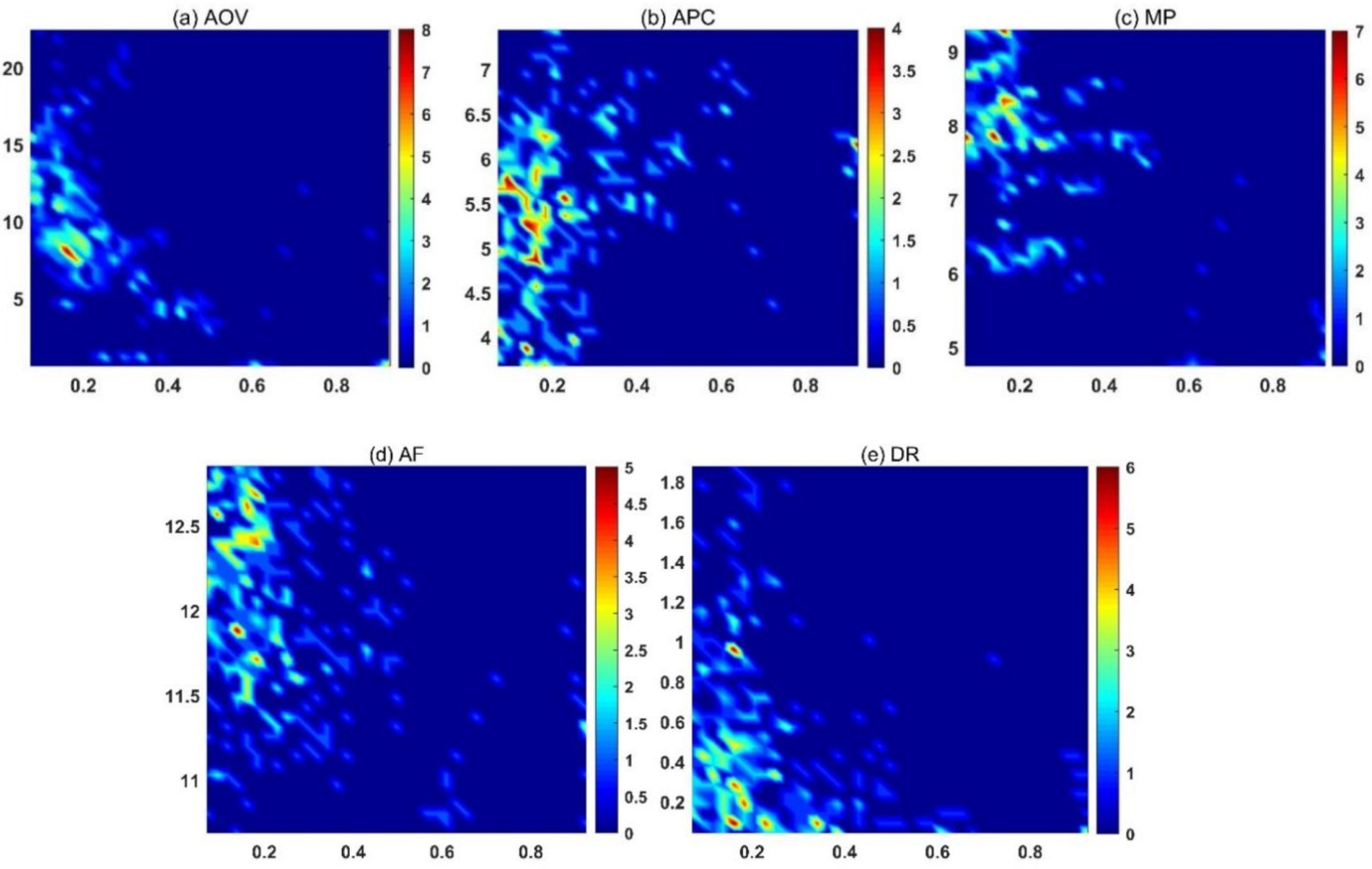
Figure 1. Density distribution diagram of data between core explanatory variables and control variables. (a–e) respectively representent density distribution between control variables (AOV, APC, MP, AF, DR) and explanatory variables.
Furthermore, to comprehensively investigate the geographical distribution of agricultural carbon emissions, Figure 2 shows the changes in it across various provincial regions from 2011 to 2021. The visual representation reveals that five provinces – Beijing, Xinjiang, Inner Mongolia, Heilongjiang, and Jilin-exhibit positive changes in agricultural carbon emissions, indicating an upward trend in these regions over the decade; In addition, agricultural carbon emissions in Qinghai, Ningxia, Shaanxi, and Guangxi have also increased slightly; Carbon emissions in most other provinces have shown a decreasing trend, especially in Shandong, Hebei, Henan, and Hubei (Figure 3).
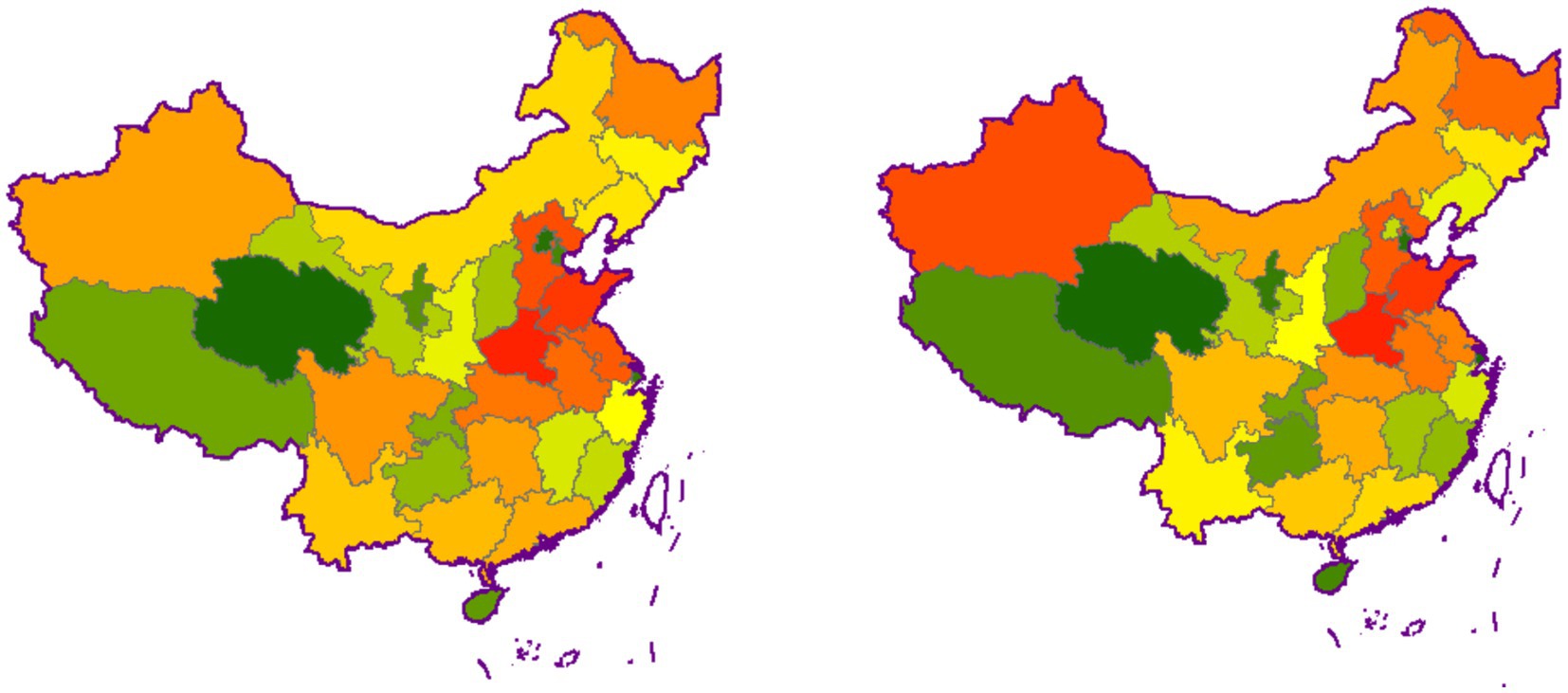
Figure 2. Distribution of agricultural carbon emissions in each province in 2011 (left) and 2021 (right).
5 Analysis of empirical results
This study employs baseline regression analyses on balanced panel data from 31 mainland Chinese provinces over 2011–2021. It examines the interplay between digital economic growth and agricultural emissions, while exploring tech-driven strategies for mitigating farm-related carbon output.
5.1 Baseline regression analysis
Table 4 presents the baseline regression results using a two-way fixed effects model (1). To assess result robustness, control variables were incrementally introduced. The findings reveal that digital economic growth consistently exhibits a significant negative correlation with agricultural emissions, regardless of control variable inclusion. Column (1) shows that, without accounting for other key factors, a 1% increase in digital economy level corresponds to a 1.022% decrease in farm-related carbon output. After incorporating additional variables, this inhibitory effect strengthens to 1.472%. The consistent significance of this relationship across models underscores the robustness of our findings. Further analysis indicates that all five control variables contribute to some extent to increased emissions in the agricultural sector (see column 6).
Furthermore, this study illustrates how the dependent variable changes with respect to the core explanatory variables and control variables, verifying the correlative relationships between various factors and agricultural carbon emissions, as shown in Figure 4. From subplots (c) and (d), it is evident that there are notable trends in the relationship between agricultural carbon emissions and both mechanical power levels and agricultural capital investment. These factors exhibit strong correlations, with agricultural carbon emissions increasing correspondingly as these control variables rise, indicating positive correlations. Subplot (e) reveals a certain correlation between agricultural carbon emissions and the agricultural disaster incidence rate, with agricultural carbon emissions decreasing as the disaster incidence rate rises, suggesting a negative correlation. In subplots (a) and (b), the correlations between agricultural carbon emissions and the control variables—agricultural output value proportion and agricultural production capacity—appear relatively weak.
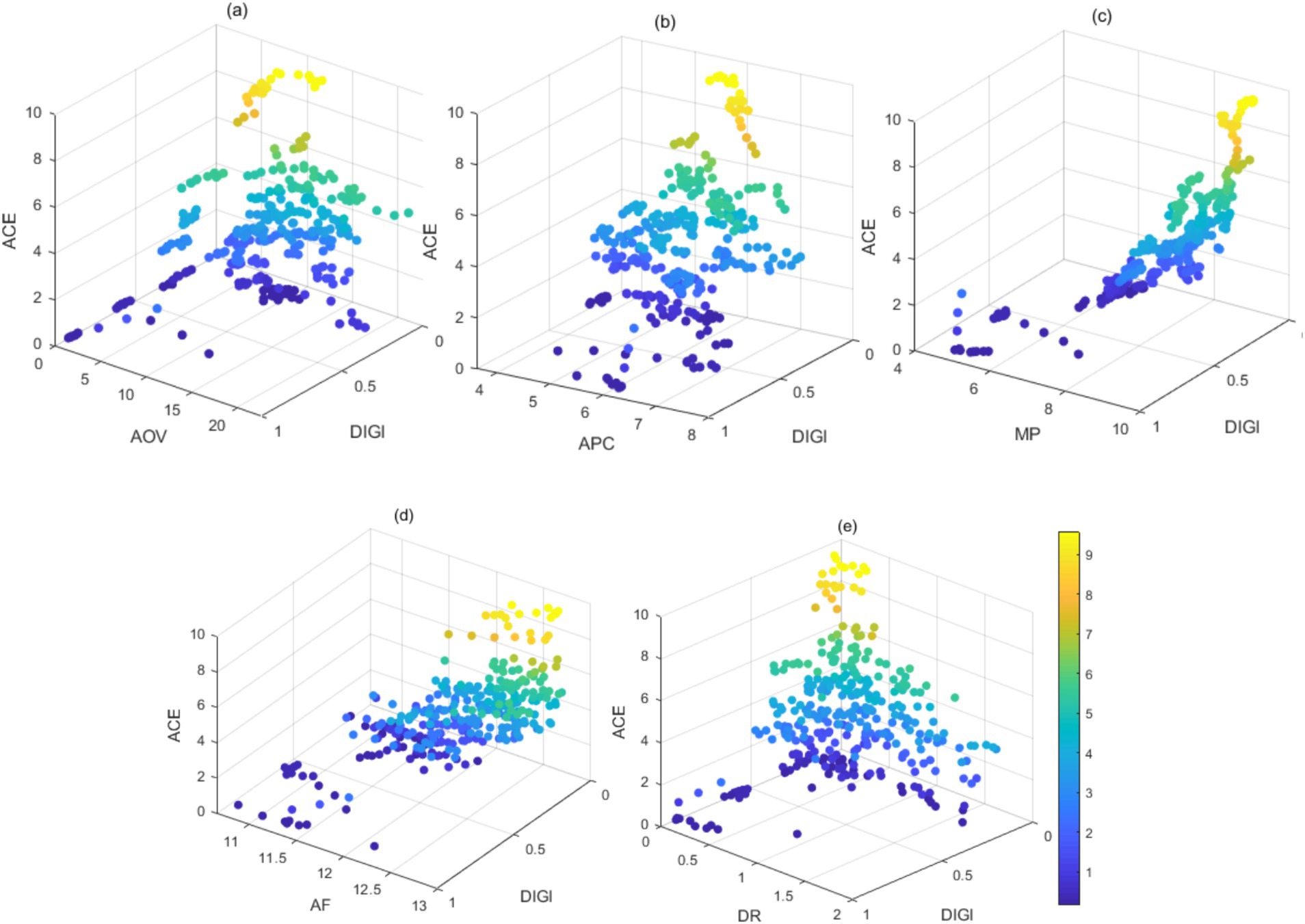
Figure 4. The relationship between agricultural carbon emissions with the level of digital economy and changes in control variables. (a–e) respectively representent density distribution between control variables (AOV, APC, MP, AF, DR) and explanatory variables.
5.2 Robustness check
To ensure robustness, the study employed multiple validation techniques. These included 1% quantile winsorization, Bootstrap random sampling (300 iterations), and alternative measurements of the key explanatory variable. Table 5 presents these results. Post-winsorization, the inhibitory relationship between variables remained significant (column 1). Principal component analysis was used to recalculate provincial digital economy levels, with results corroborating the initial findings.
To address potential bidirectional causality between digital economy and agricultural emissions, ground undulation served as an instrumental variable, mitigating endogeneity concerns. The reasons are as follows: Firstly, core digital infrastructure deployment and the Internet popularization are constrained by ground undulations. Furthermore, as a natural geographical feature, ground undulation has a natural attribute that is not subject to human intervention. In addition, after controlling for covariates such as agricultural mechanization level and agricultural input, the path from ground undulation to mechanization to carbon emissions was blocked, satisfying the exclusivity constraint. LM and Wald F statistics validated this approach. Under controlled endogeneity, the digital economy’s role in agricultural carbon reduction maintained its significance.
5.3 Analysis of time dynamic effects
In accordance with the hypothesis, the digital level exhibits a lagged effect on agricultural carbon emissions. To examine this phenomenon, core explanatory variables with varying lag periods are incorporated to conduct a temporal dynamic effect analysis. Columns (1) through (3) illustrate the impact of digital economy development levels with one-period, two-period, and three-period lags on agricultural carbon emissions, respectively. Table 6 demonstrates that significant effects for both one-period and two-period lags, revealing that through the phase, the digital economy plays a negative role in agricultural carbon reduction for both the current and subsequent periods. Nevertheless, the three-period lag proves insignificant, potentially due to the delayed spillover effects arising from infrastructure improvements and technological advancements over time. These effects allow the inhibitory influence to persist, yet this continuation tends to dissipate by the third period.
5.4 Heterogeneity analysis
Unbalanced urban economy, innovative capacity, and industrial progress may influence the mitigating effect of the digital economy on agricultural carbon emissions. To examine this phenomenon, the research sample was categorized into three major regions—Eastern, Central, and Western—as well as two broader areas—Southern and Northern. Regression analyses were conducted, with results shown in Table 7.
The result reveals significant negative impacts in both Eastern and Western regions, indicating that the digital economy exerts a substantial inhibitory effect on agricultural carbon emissions in these areas, while the Central region shows no significant effect. In terms of impact intensity, the inhibitory effect on the Western region (coefficient of −2.826) is markedly stronger than that of the Eastern region (coefficient of −1.376). Regarding the North–South divide, the Northern region exhibits a significant carbon reduction effect (coefficient of −1.963), while the effect in the Southern region is less pronounced. The regional disparities may be attributed to several factors: Geographically, the Central region’s industrial structure is stable, with industry as the dominant sector, the digital economy development in this area is at an intermediate level with relatively modest growth, hence the insignificant carbon reduction effect in the agricultural sector. The Western region, though late in initiating digital economy development, has experienced rapid growth. At the same time, the mechanization rate of agriculture in the western region is relatively low, and the marginal benefits of digital technology replacing traditional high carbon operations are higher, resulting in a stronger inhibitory effect on agricultural carbon emissions. In the eastern region, existing technologies have locked in the space for emission reduction, so the emission reduction elasticity of digital technology is relatively low. Comparing the Southern and Northern regions, the North has a larger proportion of agricultural industry, leading to a more significant inhibitory effect of the digital economy on carbon emissions. At the same time, the overexploitation area of groundwater in North China is relatively wide, and the carbon emissions generated by pumping electricity are an important component of agricultural carbon emissions. Digital irrigation systems improve irrigation efficiency while reducing carbon emissions generated by electricity consumption through soil moisture monitoring. The Southern region, while relatively advanced in digital economy development, has slower growth and a smaller proportion of agricultural output, thus the inhibitory effect of the digital economy on agricultural carbon reduction is less evident.
5.5 Intermediary effect analysis
Table 8 presents the mediating variable test results for Hypothesis 3. Columns (1)–(2) analyze fertilizer application rates, revealing a significant negative correlation between digital economy growth and fertilizer usage. This mediating effect suggests that technological advancements contribute to reduced carbon emissions in agriculture through more efficient fertilizer management. Columns (3)–(4) focus on crop yield rates. The findings indicate that digital innovations enhance agricultural productivity, consequently lowering carbon output. This dual-pathway analysis demonstrates how the digital economy simultaneously optimizes input efficiency and boosts output, leading to overall emission reduction in the farming sector.
In summary, both fertilizer reduction and yield increase exhibit significant mediating effects. Specifically, empowered by digital technology, agricultural production experiences a decrease in fertilizer usage and an increase in crop yields. This leads to higher returns and optimized agricultural structures, ultimately resulting in reduced agricultural carbon emissions.
5.6 Moderating effect analysis
To validate the moderating effect of government fiscal expenditure, environmental protection and science and technology fiscal expenditures were incorporated as moderating variables into the baseline regression model. Interaction terms were constructed with the digital economy level, establishing models (3) and (4), with results detailed in Table 9.
The findings reveal that fiscal support for environmental protection and science and technology significantly enhances the digital economy’s impact on agricultural carbon reduction. Interaction coefficients between these fiscal supports and the digital economy are 1.784 (p < 0.05) and 1.153 (p < 0.1) respectively, indicating positive synergies. As government investment in these areas increases, the digital economy’s mitigating effect on farm-related emissions intensifies. This underscores the crucial role of targeted fiscal policies in leveraging digital innovations for sustainable agriculture, thus substantiating Hypothesis 3 (Table 9).
6 Research conclusions and policy recommendations
Through the digital era, data-driven decision-making engendered by the digital economy propels the advancement of intelligent agriculture. The interconnectivity of information cultivates a digitalized agricultural ecosystem, while technological iterations lay the groundwork for high-quality agricultural development, steering the sector toward a greener, low-carbon trajectory. Grounded in theoretical analysis and hypotheses, this study employs provincial panel data from China spanning 2011–2021 as its research sample, utilizing modeling techniques to explore the intrinsic connection between the digital economy and agricultural carbon emissions, elucidating the transmission mechanisms between the two. The research findings reveal: (1) the digital economy has a substantial negative impact on carbon emissions from agriculture. After controlling for other factors, a 1% increase in the digital economy level corresponds to a 1.472% reduction in agricultural carbon emissions, with the robustness of this result confirmed, which further verification of the important role of technological progress in sustainable agricultural development. (2) Regarding temporal effects, the negative impact of the digital economy on agricultural carbon emissions is not only evident in the current period but also reduces emissions in the subsequent two periods, which validates the value of the digital economy in cross period emission reduction in agriculture. (3) In terms of spatial distribution, examining China’s eastern, central, and western regions, the carbon reduction effect exhibits a spatial distribution pattern of “West > East, Central insignificant.” From a north–south perspective, the inhibitory effect on carbon emissions is more pronounced in the north, while insignificant in the south. This spatial heterogeneity has important reference value for deploying hardware facilities and software investment in the digital economy. (4) Concerning internal transmission mechanisms, the digital economy achieves suppression of carbon emissions in the agricultural sector through two mediating pathways: reducing agricultural fertilizer usage and improving crop yield rates. (5) Regarding external regulatory mechanisms, government fiscal support in environmental protection and scientific and technological domains positively reinforces the inhibitory effect of the digital economy on agricultural carbon emissions, which emphasis on the important guiding role of the government in reducing carbon emissions in agriculture. Drawing from the aforementioned findings, several strategic recommendations can be put forward:
Firstly, enhance the development and implementation of China’s digitalization initiatives and implement differentiated digital economy policies. Under the guidance of the national digital economy strategy, innovate existing development models by infusing new vitality into diverse business formats through technological empowerment. Cultivate novel economic forms and development paradigms, further promoting the comprehensive fusion of digital economy elements with agricultural production and rural construction, thus providing impetus for the transition from traditional to modern agriculture. Concurrently, cultivate the digital economy in a manner that is tailored to the specific characteristics and needs of the locality, transcending geographical constraints, integrating digital resources, optimizing resource allocation, and bridging the disparities in emission reduction effects caused by uneven regional digital economic development.
Secondly, Strengthen long-term investment in digital infrastructure and consolidate cross period emission reduction effects Implementing regional differentiation strategies to solve the dilemma of the “central depression,” such as leveraging the driving effect of the eastern region, building a digital linkage ecology between agriculture and industry in the central region, upgrading infrastructure and employment structure in the western region, deepening the adaptability of technological innovation between the north and south, activating the emission reduction potential of the south, and realizing the long-term benefits of digital economy on agricultural carbon emissions.
Thirdly, promote the deep integration and development of the digital economy and agriculture, and accelerate the digital and green transformation of agriculture. Empowering agriculture with digital technology, actively innovating and promoting the “Internet plus+Agriculture” model, enabling the whole chain of agricultural production with digital technology, running through all links before, during and after agricultural production, to achieve high-quality seed selection and breeding, precision fertilization, effective irrigation, automatic picking, etc., while transforming the agricultural production mode, reduce agricultural pollution emissions, develop green agriculture, and promote high-quality agricultural development.
Finally, increase financial investment in the digital economy and fully leverage the government’s role in optimizing the allocation of digital resources. On the one hand, we attach great importance to investment in digital infrastructure and technological innovation, solidify the strategic foundation of the digital economy, empower with digital technology, and revitalize modern agriculture. On the other hand, increasing government investment in the field of environmental protection, using mandatory and incentivized regulatory measures, cultivating low-carbon awareness among farmers, and actively enhancing the role of the digital economy in driving carbon emission reductions within the agricultural industry.
The conclusions above echo global efforts to drive decarbonization of agriculture. This study systematically explained how the agricultural sector can achieve a win-win situation of emission reduction and efficiency improvement through technological adaptation, providing a feasible micro path for agricultural carbon neutrality. However, there are still some drawbacks and future directions: As an agricultural power, China is a typical case to study, but the experience of one country is not necessarily applicable to all regions. Future research should expand the sample from one country to multiple countries; on the other hand, the micro-mechanism between the digital economy and green development is rich, and the future can supplement the mechanism perspective, such as energy pricing.
Data availability statement
The original contributions presented in the study are included in the article/supplementary material, further inquiries can be directed to the corresponding author.
Author contributions
HY: Formal analysis, Project administration, Validation, Visualization, Writing – original draft, Writing – review & editing. TW: Conceptualization, Data curation, Investigation, Methodology, Software, Supervision, Writing – original draft, Writing – review & editing.
Funding
The author(s) declare that no financial support was received for the research and/or publication of this article.
Conflict of interest
The authors declare that the research was conducted in the absence of any commercial or financial relationships that could be construed as a potential conflict of interest.
Generative AI statement
The author(s) declare that no Gen AI was used in the creation of this manuscript.
Publisher’s note
All claims expressed in this article are solely those of the authors and do not necessarily represent those of their affiliated organizations, or those of the publisher, the editors and the reviewers. Any product that may be evaluated in this article, or claim that may be made by its manufacturer, is not guaranteed or endorsed by the publisher.
Footnotes
1. ^The IPCC finalized the Synthesis Report for the Sixth Assessment Report during the Panel’s 58th Session held in Interlaken, Switzerland from 13 to 19 March 2023.
References
Abbas, J., Balsalobre-Lorente, D., Amjid, M. A., Al-Sulaiti, K., Al-Sulaiti, I., and Aldereai, O. (2024). Financial innovation and digitalization promote business growth: the interplay of green technology innovation, product market competition and firm performance. Innov. Green Dev. 3:100111. doi: 10.1016/j.igd.2023.100111
Abiri, R., Rizan, N., Balasundram, S. K., Shahbazi, A. B., and Abdul-Hamid, H. (2023). Application of digital technologies for ensuring agricultural productivity. Heliyon 9:e22601. doi: 10.1016/j.heliyon.2023.e22601
Cao, J., Li, C., Gao, X., Cai, Y., Song, X., Siddique, K. H. M., et al. (2023). Agricultural soil plastic as a hidden carbon source stimulates microbial activity and increases carbon dioxide emissions. Resour. Conserv. Recycl. 198:107151. doi: 10.1016/j.resconrec.2023.107151
Chen, L., and He, R. (2024). Does digital tax enforcement drive corporate digitalization? Evidence from the Golden tax project III in China: a pre-registered report. Pac. Basin Financ. J. 83:102242. doi: 10.1016/j.pacfin.2023.102242
Chen, M., Xiao, H., Zhao, H., and Liu, L. (2024). The power of attention: government climate-risk attention and agricultural-land carbon emissions. Environ. Res. 251:118661. doi: 10.1016/j.envres.2024.118661
Clò, S., Frigerio, M., and Vandone, D. (2022). Financial support to innovation: the role of European development financial institutions. Res. Policy 51:104566. doi: 10.1016/j.respol.2022.104566
Costa, F., Frecassetti, S., Rossini, M., and Portioli-Staudacher, A. (2023). Industry 4.0 digital technologies enhancing sustainability: applications and barriers from the agricultural industry in an emerging economy. J. Clean. Prod. 408:137208. doi: 10.1016/j.jclepro.2023.137208
Dai, S., Su, M., Liu, Y., and Xu, Z. (2023). Digital economy, resource richness, external conflicts, and ecological footprint: evidence from emerging countries. Resour. Policy 85:103976. doi: 10.1016/j.resourpol.2023.103976
Du, Y., Liu, H., Huang, H., and Huang, H. (2023). The carbon emission reduction effect of agricultural policy—evidence from China. J. Clean. Prod. 406:137005. doi: 10.1016/j.jclepro.2023.137005
Fan, X., Lu, X., and Liu, J. (2023). Effects of digital economy development on the urban land green use efficiency: based on the moderating effect of infrastructure construction China land. Science 37, 79–89. doi: 10.11994/zgtdkx.20230512.085730
Ganda, F. (2023). The influence of agricultural policy on carbon emissions in selected OECD countries. Heliyon 9:e19881. doi: 10.1016/j.heliyon.2023.e19881
Guan, K., Jin, Z., Peng, B., Tang, J., DeLucia, E. H., West, P. C., et al. (2023). A scalable framework for quantifying field-level agricultural carbon outcomes. Earth-Sci. Rev. 243:104462. doi: 10.1016/j.earscirev.2023.104462
Guo, Z., and Zhang, X. (2023). Carbon reduction effect of agricultural green production technology: a new evidence from China. Sci. Total Environ. 874:162483. doi: 10.1016/j.scitotenv.2023.162483
Janus, J., and Ertunç, E. (2023). Impact of land consolidation on agricultural decarbonization: estimation of changes in carbon dioxide emissions due to farm transport. Sci. Total Environ. 873:162391. doi: 10.1016/j.scitotenv.2023.162391
Koondhar, M. A., Udemba, E. N., Cheng, Y., Khan, Z. A., Batool, M., and Kong, R. (2021). Asymmetric causality among carbon emission from agriculture, energy consumption, fertilizer, and cereal food production – a non-linear analysis for Pakistan. Sustain Energy Technol Assess 45:101099. doi: 10.1016/j.seta.2021.101099
Li, J., Gao, M., Luo, E., Wang, J., and Zhang, X. (2023). Does rural energy poverty alleviation really reduce agricultural carbon emissions? The case of China. Energy Econ. 119:106576. doi: 10.1016/j.eneco.2023.106576
Li, L., Han, J., and Zhu, Y. (2023). Does environmental regulation in the form of resource agglomeration decrease agricultural carbon emissions? Quasi-natural experimental on high-standard farmland construction policy. J. Clean. Prod. 420:138342. doi: 10.1016/j.jclepro.2023.138342
Liu, J., Chen, Y., and Liang, F. H. (2023). The effects of digital economy on breakthrough innovations: evidence from Chinese listed companies. Technol. Forecast. Soc. Change 196:122866. doi: 10.1016/j.techfore.2023.122866
Liu, Y., and Gao, Y. (2022). Measurement and impactor analysis of agricultural carbon emission performance in Changjiang economic corridor. Alex. Eng. J. 61, 873–881. doi: 10.1016/j.aej.2021.04.083
Liu, M., and Yang, L. (2021). Spatial pattern of China’s agricultural carbon emission performance. Ecol. Indic. 133:108345. doi: 10.1016/j.ecolind.2021.108345
Liu, Y., Zhao, X., Liu, Y., and Kong, F. (2023). The dynamic impact of digital economy on the green development of traditional manufacturing industry: evidence from China. Econ. Anal. Policy 80, 143–160. doi: 10.1016/j.eap.2023.08.005
Liu, D., Zhu, X., and Wang, Y. (2021). China's agricultural green total factor productivity based on carbon emission: an analysis of evolution trend and influencing factors. J. Clean. Prod. 278:123692. doi: 10.1016/j.jclepro.2020.123692
Ma, Q., Mentel, G., Zhao, X., Salahodjaev, R., and Kuldasheva, Z. (2022). Natural resources tax volatility and economic performance: evaluating the role of digital economy. Resour. Policy 75:102510. doi: 10.1016/j.resourpol.2021.102510
Pan, M., and Zhang, J. (2023). Financial expenditure on science and technology, digital economy and high-quality economic development——empirical test based on provincial panel data. Modernizat. Manag. 43, 29–37. doi: 10.19634/j.cnki.11-1403/c.2023.04.004
Pang, H., Liu, X., and Gong, Y. (2024). Development of the Internet of Things, Technological Innovation, and Agricultural Carbon Emission Intensity [J]. Economic Issues. Economic Issues, 77–83. doi: 10.16011/j.cnki.jjwt.2024.02.001
Raihan, A., Ibrahim, S., and Muhtasim, D. A. (2023). Dynamic impacts of economic growth, energy use, tourism, and agricultural productivity on carbon dioxide emissions in Egypt. World Dev. Sustain. 2:100059. doi: 10.1016/j.wds.2023.100059
Raihan, A., and Tuspekova, A. (2022). Nexus between economic growth, energy use, agricultural productivity, and carbon dioxide emissions: new evidence from Nepal. Energy Nexus 7:100113. doi: 10.1016/j.nexus.2022.100113
Şerbu, R. S. (2014). An interdisciplinary approach to the significance of digital economy for competitiveness in Romanian rural area through E-agriculture. Procedia Econ. Finance 16, 13–17. doi: 10.1016/S2212-5671(14)00768-0
Shabbir Alam, M., Duraisamy, P., Bakkar Siddik, A., Murshed, M., Mahmood, H., Palanisamy, M., et al. (2023). The impacts of globalization, renewable energy, and agriculture on CO2 emissions in India: contextual evidence using a novel composite carbon emission-related atmospheric quality index. Gondwana Res. 119, 384–401. doi: 10.1016/j.gr.2023.04.005
Su, L., Wang, Y., and Yu, F. (2023). Analysis of regional differences and spatial spillover effects of agricultural carbon emissions in China. Heliyon 9:e16752. doi: 10.1016/j.heliyon.2023.e16752
Sui, J., Lv, W., Xie, H., and Xu, X. (2024). Towards low-carbon agricultural production: evidence from China's main grain-producing areas. Financ. Res. Lett. 60:104952. doi: 10.1016/j.frl.2023.104952
Tongwane, M. I., Moeletsi, M. E., and Tsubo, M. (2020). Trends of carbon emissions from applications of nitrogen fertiliser and crop residues to agricultural soils in South Africa. J. Environ. Manag. 272:111056. doi: 10.1016/j.jenvman.2020.111056
Turid, K. G., Butli, H. R. M., and Petter, S. E. (2022). The role of farmers’ microAKIS at different stages of uptake of digital technology. J. Agric. Educ. Ext. 28, 671–688. doi: 10.1080/1389224X.2022.2046617
Wang, Z., Martha, G. B., Liu, J., Lima, C. Z., and Hertel, T. W. (2024). Planned expansion of transportation infrastructure in Brazil has implications for the pattern of agricultural production and carbon emissions. Sci. Total Environ. 928:172434. doi: 10.1016/j.scitotenv.2024.172434
Wang, R., Zhang, Y., and Zou, C. (2022). How does agricultural specialization affect carbon emissions in China? J. Clean. Prod. 370:133463. doi: 10.1016/j.jclepro.2022.133463
Wei, Z., Wei, K., Liu, J., and Zhou, Y. (2023). The relationship between agricultural and animal husbandry economic development and carbon emissions in Henan Province, the analysis of factors affecting carbon emissions, and carbon emissions prediction. Mar. Pollut. Bull. 193:115134. doi: 10.1016/j.marpolbul.2023.115134
Wei, S., Yang, Y., and Xu, Y. (2023). Regional development, agricultural industrial upgrading and carbon emissions: what is the role of fiscal expenditure? —-evidence from Northeast China. Econ. Anal. Policy 80, 1858–1871. doi: 10.1016/j.eap.2023.11.016
Wu, D., Zhang, Z., Liu, D., Zhang, L., Li, M., Khan, M. I., et al. (2024). Calculation and analysis of agricultural carbon emission efficiency considering water–energy–food pressure: modeling and application. Sci. Total Environ. 907:167819. doi: 10.1016/j.scitotenv.2023.167819
Wu, X., Zhang, J., Tian, Y., et al. (2014). Provincial agricultural carbon emissions in China: calculation, performance change and influencing factors. Resour Sci 36, 129–138.
Xiong, M., Zhang, F., Zhang, H., and Wang, H. (2023). Digital economy, credit expansion, and modernization of industrial structure in China. Financ. Res. Lett. 58:104500. doi: 10.1016/j.frl.2023.104500
Yang, C., Ji, X., Cheng, C., Liao, S., Obuobi, B., and Zhang, Y. (2024). Digital economy empowers sustainable agriculture: implications for farmers’ adoption of ecological agricultural technologies. Ecol. Indic. 159:111723. doi: 10.1016/j.ecolind.2024.111723
Yang, H., Wang, X., and Bin, P. (2022). Agriculture carbon-emission reduction and changing factors behind agricultural eco-efficiency growth in China. J. Clean. Prod. 334:130193. doi: 10.1016/j.jclepro.2021.130193
Yu, H., Wang, J., Hou, J., Yu, B., and Pan, Y. (2023). The effect of economic growth pressure on green technology innovation: do environmental regulation, government support, and financial development matter? J. Environ. Manag. 330:117172. doi: 10.1016/j.jenvman.2022.117172
Yu, H., Wei, W., Li, J., and Li, Y. (2022). The impact of green digital finance on energy resources and climate change mitigation in carbon neutrality: case of 60 economies. Resour. Policy 79:103116. doi: 10.1016/j.resourpol.2022.103116
Zhang, L., Cai, C., Singh, K., and Zhong, K. (2024). Green technology innovation, trade deficit and carbon emission transfer in agriculture under the new “dual circulation” development pattern of China. Ecol. Indic. 159:111757. doi: 10.1016/j.ecolind.2024.111757
Zhang, X., Wu, L., Ma, X., and Qin, Y. (2022). Dynamic computable general equilibrium simulation of agricultural greenhouse gas emissions in China. J. Clean. Prod. 345:131122. doi: 10.1016/j.jclepro.2022.131122
Zhao, R., Liu, Y., Tian, M., Ding, M., Cao, L., Zhang, Z., et al. (2018). Impacts of water and land resources exploitation on agricultural carbon emissions: the water-land-energy-carbon nexus. Land Use Policy 72, 480–492. doi: 10.1016/j.landusepol.2017.12.029
Zhao, L., Rao, X., and Lin, Q. (2023). Study of the impact of digitization on the carbon emission intensity of agricultural production in China. Sci. Total Environ. 903:166544. doi: 10.1016/j.scitotenv.2023.166544
Zhao, T., Zhang, Z., and Liang, S. (2020). Digital economy, entrepreneurship, and high-quality economic development: empirical evidence from urban China. J. Manag. World 36, 65–76. doi: 10.19744/j.cnki.11-1235/f.2020.0154
Keywords: digital economy, agricultural carbon emissions, fertilizer conservation, yield increase, financial support
Citation: Yang H and Wen T (2025) Study on the influence mechanism of digital economy on agricultural carbon emission reduction-based on the perspective of fertilizer saving and efficiency improvement. Front. Sustain. Food Syst. 9:1519109. doi: 10.3389/fsufs.2025.1519109
Edited by:
Siphe Zantsi, Agricultural Research Council of South Africa (ARC-SA), South AfricaReviewed by:
Fan Xuerui, Lanzhou University, ChinaChang Ming, Chinese Academy of Agricultural Sciences (CAAS), China
Copyright © 2025 Yang and Wen. This is an open-access article distributed under the terms of the Creative Commons Attribution License (CC BY). The use, distribution or reproduction in other forums is permitted, provided the original author(s) and the copyright owner(s) are credited and that the original publication in this journal is cited, in accordance with accepted academic practice. No use, distribution or reproduction is permitted which does not comply with these terms.
*Correspondence: Tiejun Wen, ZXRoYW55YW5nMDIxNUAxNjMuY29t
 He Yang1
He Yang1 Tiejun Wen
Tiejun Wen